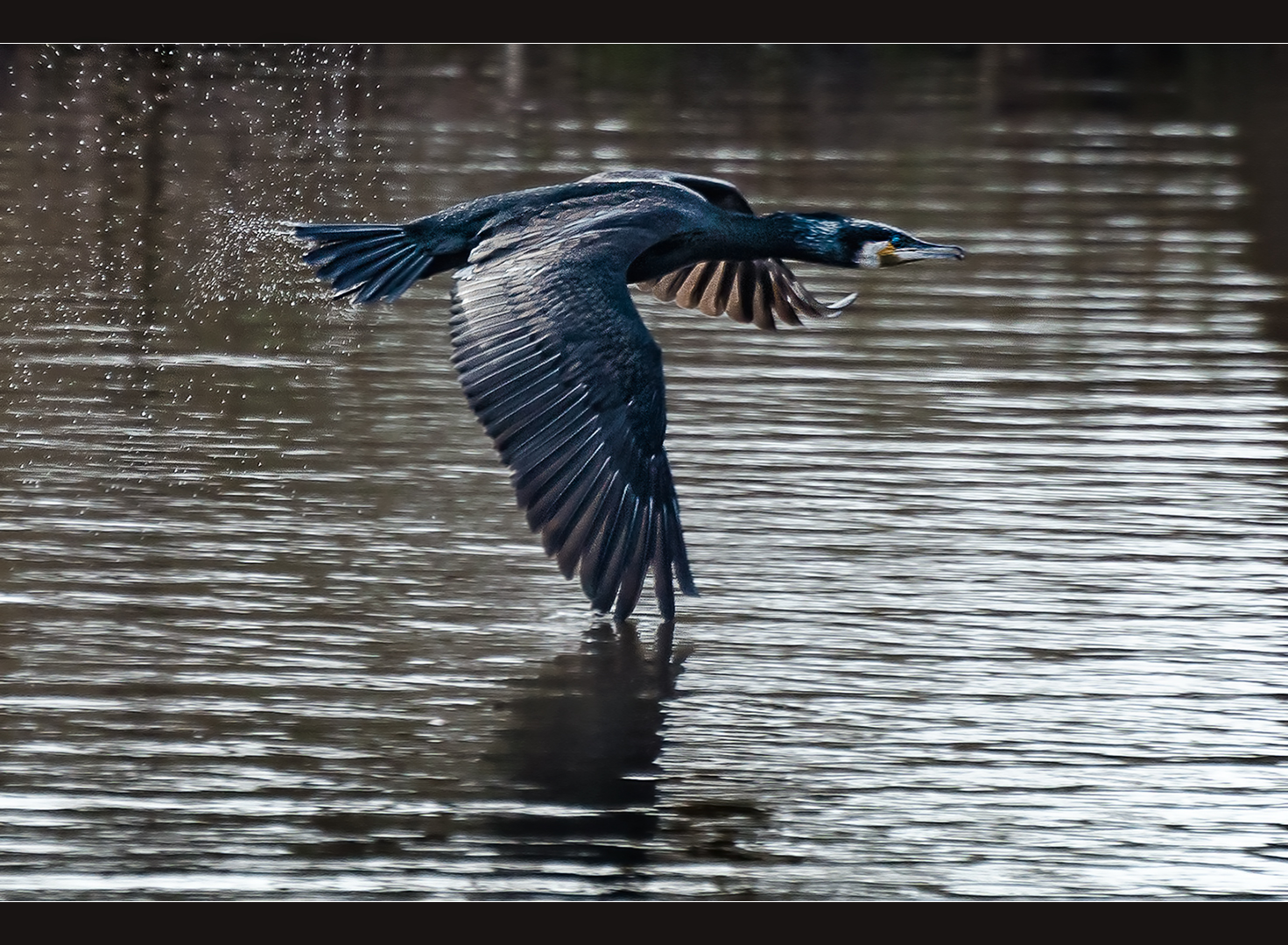A short dip of the wing
The cormorant in the southpark to Duesseldorf showed an absolutely precise low-altitude flight and dipped its wing briefly into the water of the lake, just for the part of a second. A lower flight really wouldn't work anymore.
Ein kurzes Eintauchen des Flügels
Der Kormoran im Düsseldorfer Südpark legte einen absolut präzisen Tiefflug hin und tauchte seinen Flügel dabei kurzfristig, minimal in das Wasser des Sees. Niedriger ging es wirklich nicht mehr.

Der Regenmacher
Manuel Gloger

Warten... / Waiting...
Manuel Gloger
Warum der Galapagos-Kormoran das Fliegen verlernte
"Veränderungen in einer Reihe von Genen haben den Kormoran der Galapagosinseln im Laufe der vergangenen zwei Millionen Jahre flugunfähig gemacht. Sie sorgten dafür, dass die Vögel heute statt kräftiger Schwingen nur stummelige Flügelchen haben. Flugunfähige Vogelarten gibt es einige - man denke an Strauße, Emus, Kiwis und natürlich Pinguine.
Die auf den Galapagosinseln Isabela und Fernandina lebende flugunfähige Art heißt im Deutschen Galapagosscharbe - oder auch Stummelkormoran. Damit ist sein Äußeres in aller Kürze recht treffend beschrieben: Die Flügel des Vogels sind zu zwei Stummeln verkürzt. Auch seine Brustmuskeln sind unterentwickelt, einige andere Körpermerkmale verändert.
Die Analyse des Erbguts zeigte nun, dass bei diesem Vogel eine Reihe von Genen mutiert ist, die mit der Bildung und Funktion von Cilien in Verbindung stehen. Cilien sind haarähnliche Ausstülpungen auf Zellen, die etwa für die Kommunikation der Zellen untereinander notwendig sind. Fehlen in einem Lebensraum etwa Feinde, vor denen man rasch fortfliegen muss, kann es sich auszahlen, auf die Bildung von imposanten Flügeln zu verzichten - sie stören nämlich nur beim Tauchen auf der Jagd nach Futter.
Vögel, die aufgrund von genetischen Mutationen nur Stummelflügel ausbilden, sind dann nicht im Nachteil, sondern im Vorteil. Ihre Überlebenswahrscheinlichkeit steigt, sie produzieren mehr Nachkommen, an die sie ihre Mutationen weiterreichen - bis sich das Merkmal im Laufe von Jahrmillionen der Evolution in der Population durchsetzt."
Quelle:https://www.hna.de/welt/warum-galapagos-kormoran-fliegen-verlernte-zr-8373544.html
Why the Galapagos Cormorant failed to fly
"Changes in a number of genes have rendered the Galapagos Cormorant flightless over the past two million years, making the birds today only have stubby wings instead of powerful wings." There are some flightless bird species - think of ostriches, emus , Kiwis and of course penguins.
The flightless species living in the Galapagos Isabela and Fernandina is called in German Galapagosscharbe - or Stummelkormoran. In a nutshell, his appearance is very aptly described: The wings of the bird are shortened to two stubs. His pectoral muscles are also underdeveloped, some other body features changed.
Genetic analysis has now shown that this bird has mutated a number of genes related to the formation and function of cilia. Cilia are hair-like protuberances on cells, which are necessary for the communication between the cells. If there are no enemies in a habitat to flee quickly, it may be worthwhile to forego the formation of imposing wings - they only disturb the hunt for food while diving.
Birds that only form stub wings due to genetic mutations are then not at a disadvantage, but at an advantage. Their likelihood of survival increases, they produce more offspring to pass on their mutations - until the feature prevails in the population over millions of years of evolution."























noblog 24/03/2018 19:44
klasse im Flug erwischtDir einen schönes Wochenende
LG Norbert
Ottmar Niessen 23/03/2018 18:38
Wunderbar gesehen, fotografiert und dargestellt...gefällt mir sehr...Lieben Gruß
Ottmar.....wieder aus Südafrika zurück
Doris Mitecki 22/03/2018 1:40
Der Flügeldipper ist genial*** lg DorisDiruwi 21/03/2018 23:25
Aber Deinem Radar konnte der Tiefflieger dann doch nicht entwischen! :-)Super erwischt, und schön mit den Tröpfchen!
Alles Gute, Dietmar
hans-jakob 21/03/2018 16:18
Tolle Flugszene super eingefangen!!!LG hans-jakob
Doris Servos 20/03/2018 23:36
Hier ist er ja GsD. ein richtiger Flugkünstler wie dein schönes Foto eindrücklich zeigt.Die Wasserspritzer machen das Bild zusätzlich interessant.
Mal eine dumme Frage: Hast du in früheren Zeiten Kormorane in Düsseldorf gesehen?
Aus der alten Heimat kenne ich keine und hier sind sie erst seit 3 Jahren unterwegs.
LG Doris
Petra-Maria Oechsner 20/03/2018 20:22
so elegant fliegend und aus der nähe habe ich einen kormoran noch nicht gesehen !!die wasserpritzer, die er hinter sich lässt und sein zielgerichteter aufmerksamer blick sind ein weiteres highlight...:-)
und...interessant auch deine infos zu den galapagos kormoranen
lg petra
Claudio Micheli 20/03/2018 18:39
...è bella!...molto!Ciao
Markus Novak 20/03/2018 17:58
WOWwirklich beeindruckend!!
LG markus
Vitória Castelo Santos 20/03/2018 15:42
ein klasse Motiv... mit einer feinen Spiegelung.LG Vitoria
Conny Müller 20/03/2018 14:57
Eine perfekte Flugaufnahme, ziehe meinen Hut.LG
Conny
Lady Durchblick 20/03/2018 13:54
bestens erwischt.... im Tiefflugklasse Aufnahme
LG Ingrid
Harold Thompson 20/03/2018 12:56
Good timing to catch the moment the tip touched:-)) Harold
Gerd Frey 20/03/2018 9:56
die schräglage kommt wohl vom ausschütteln des schwanzes :-)ein gute rmoment.
vg gerd
† Dieter Uhlig. 20/03/2018 8:42
wie ein pfeil